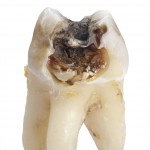
Alveolar osteitis or dry socket is a common and painful complication of tooth extraction, occurring following about 5% of all tooth extractions. The aetiology of this complication is unclear and it has been associated with a wide range of risk factors. the aim of this study was to assess the relation between 8 risk factors (patient gender, oral hygiene, tooth location, previous surgical site infection, traumatic extraction, systemic diseases, alcohol consumption, and tobacco use) and the development of alveolar osteitis.
This was a prospective nested case-control study. From a baseline cohort of 1423 adults who underwent dental extractions in a public community dental clinic in, Chile 80 incident case patients with alveolar osteitis were identified. Theses were compared with 80 controls randomized from all control participants completing the follow-up (1,222). Data on the 8 predictor variables (risk factors), namely patient gender, hygiene, tooth location, previous surgical site infection, traumatic extraction, systemic diseases, alcohol consumption, and tobacco use were collected and a binary regression logistic analysis was performed to determine significant associations.
They found
- An overall incidence of Alveolar osteitis of 6.14% .
- A statistically significant association for the development of alveolar osteitis was found for traumatic extraction ,tobacco smoking after extraction and previous surgical site infection.
[table id=18 /]
The authors concluded
In this study, traumatic extraction, tobacco use, and previous surgical site infection were identified as risk factors for the development of alveolar osteitis.
Halabí D, Escobar J, Muñoz C, Uribe S. Logistic Regression Analysis of Risk Factors for the Development of Alveolar Osteitis. J Oral Maxillofac Surg. 2012 Feb 4. [Epub ahead of print] PubMed PMID: 22305872

Alveolar osteitis or dry socket is the condition occuring after tooth extraction when the clot gets dislodged due to one or the other reason. It requires immediate consultation of dentist. It is most commonly seen during wisdom tooth extraction. It is usually treated with gauze mixed with ZOE. Visit for more info : http://www.identalhub.com/dental-what-is-dry-socket-879.aspx
The dental hub link provides a nice overview however for those wanting more details you might want to look at these 4 systematic reviews of the area.
1: Kolokythas A, Olech E, Miloro M. Alveolar osteitis: a comprehensive review of concepts and controversies. Int J Dent. 2010;2010:249073. Epub 2010 Jun 24.PubMed PMID: 20652078; PubMed Central PMCID: PMC2905714.
2: Noroozi AR, Philbert RF. Modern concepts in understanding and management of the dry socket syndrome: comprehensive review of the literature. Oral Surg OralMed Oral Pathol Oral Radiol Endod. 2009 Jan;107(1):30-5. Epub 2008 Aug 28.Review. PubMed PMID: 18755610.
3: Hedström L, Sjögren P. Effect estimates and methodological quality of randomized controlled trials about prevention of alveolar osteitis following tooth extraction: a systematic review. Oral Surg Oral Med Oral Pathol Oral Radiol Endod. 2007 Jan;103(1):8-15. Epub 2006 Apr 24. Review. PubMed PMID: 17178488.
4: Caso A, Hung LK, Beirne OR. Prevention of alveolar osteitis with chlorhexidine: a meta-analytic review. Oral Surg Oral Med Oral Pathol Oral Radiol Endod. 2005 Feb;99(2):155-9. PubMed PMID: 15660084.
sir, i wanted to know about the amount of bone resoption that takes place in regard to both height and width after traumatic extractions
[…] Dental Elf – 14th Feb 2012 – Traumatic extraction carries a high risk of a painful dry soc… […]